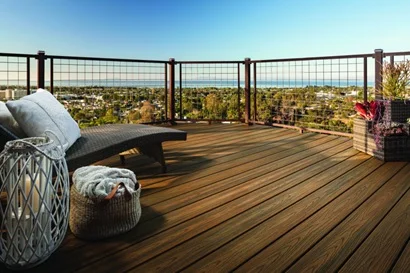Composite deck boards are durable, attractive, and eco-friendly. Composite decking has improved in appearance and technology due to manufacturers’ continual research and development. How to utilize composite decking? Let’s investigate further.
Composite decking considerations
You create a composite deck to improve your outside living space. To make the outside space durable and appealing, we need to use composite decking properly.
First, make sure composite decking is supported by a solid supporting structure constructed of pressure-treated wood or steel. Keep the substructure level and supported to avoid sagging or buckling.
To prevent temperature expansion, allow an 8mm gap between composite wood decking planks. Use hidden fasteners to attach decking boards to the framing and follow manufacturer instructions.
Clean composite decking periodically with mild soapy water to remove grime and stains without chemicals or power cleaning. These steps will provide you years of gorgeous, durable, and low-maintenance composite decking.
Types of Composite Decking
Composite decking offers additional alternatives because it’s man-made. Composite decking offers innovative decking designs that wood decking can’t.
Uncapped composite decking
The most popular type of composite deck board is uncapped, which is affordable and weather and mildew-resistant. You and your family can go barefoot without worry since it won’t warp or crack. The deck’s wood-like surface lets you enjoy nature.
Capped composite decking
Capped composite decking performs better with a polymer shell. Which resists stains, fading, and color fading better than composite decking. That makes it harder for water and pests to enter the composite. Of course, capped composite decking costs more than uncapped.
PVC Decking
Another durable substance is PVC. This poly-recorded vinyl PVC resists water and mold. PVC decks dissipate heat, are flame retardant, and scratch-resistant better than organic alternatives.
They are lightweight and ideal for roof decks. The material has a 30-year fading and staining warranty and a lifetime flaw, termite, and rot warranty. Naturally, its plastic texture makes it unsuitable for homeowners who seek a natural wood grain.
Composite decking board shapes
Like wood decking, composite decking is available in several sizes. You should weigh the merits and cons of each type:
Solid composite decking
Solid composite wood decking is rectangular and resembles wood. Screw the top in like a piece of wood. Some composites are heavier but harder.
Hollow composite decking
This composite wood decking is lighter and easier to move than solid composite decking. The hole in the core allows deck ventilation, keeping your outside deck in good condition.
3D Woodgrain
Composite decks have the same surface texture, hollow or solid. 3D wood grain surface gives you the feel of solid wood boards so you can enjoy nature without worrying about wood deck care.
Textured
Your deck can look different with a grooved surface. Living in a coastal or rainy area. Composite decking with grooves is ideal. Because of its grooved surface, composite decking planks are not slippery in rain. This prevents weather-related safety risks.
Color selection for composite decking
Deck color is the most sensitive but not the most essential factor. You can be bold when decorating your outdoor living space using composite decking boards’ many hues.
Consider how to coordinate colors to create the greatest house design. Ask yourself these questions when choosing colors:
- Does the deck link to an inner room?
- Do you want the deck to match the patio color?
- What color is the railing? Does it match the house’s trim or style?
Deck Construction Preparation
Building Permits
Check if you need a building permit before building a deck. Check with your local government or a deck contractor to see if permits are needed.
Composite decking joists
Composite decking is structured differently than wood. Joists must be 16 inches apart or 12 inches if the running boards are 45 degrees.
Let sit
Let composite decking planks lay horizontally for a week before installing them. This allows the composite decking material to adapt to local temperatures and humidity and prevent expansion and contraction after installation.
In summary
Select the appropriate composite decking for your situation. If you have questions, email us. COOWIN offers a skilled service team to answer questions.
For more information click here.









